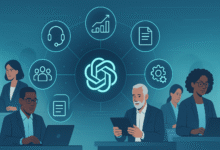Top 7 Cybersecurity Threats You Must Know in 2025
As we navigate through 2025, understanding the most pressing cybersecurity threats has become more crucial than ever for individuals, businesses, and organizations worldwide.

The digital landscape continues to evolve at breakneck speed, and with it, the sophistication of malicious actors seeking to exploit vulnerabilities in our interconnected world. As we navigate through 2025, understanding the most pressing cybersecurity threats has become more crucial than ever for individuals, businesses, and organizations worldwide. The cost of cyber attacks has reached unprecedented levels, with global damages expected to exceed $10.5 trillion annually by the end of 2025.
Modern threat actors have adapted their strategies, leveraging artificial intelligence, machine learning, and advanced persistent threat techniques to bypass traditional security measures. From ransomware attacks that cripple entire healthcare systems to sophisticated social engineering schemes that target unsuspecting individuals, the cybersecurity threat landscape demands constant vigilance and proactive defense strategies.
This comprehensive guide explores the seven most critical cybersecurity threats that pose significant risks in 2025, providing you with the knowledge and tools necessary to protect yourself and your organization from these evolving digital dangers.
1. AI-Powered Ransomware Attacks
The Evolution of Ransomware
Ransomware has evolved from simple file encryption schemes to sophisticated, AI-enhanced attacks that can adapt to security measures in real-time. Modern ransomware variants leverage artificial intelligence to identify the most valuable data within targeted systems, customize encryption methods, and even negotiate ransom demands based on the victim’s financial capacity.
The integration of machine learning algorithms allows these malicious programs to evade detection by traditional antivirus software and security solutions. Advanced ransomware strains can now analyze network traffic patterns, identify backup systems, and strategically time their attacks for maximum impact.
Double and Triple Extortion Tactics
Contemporary ransomware groups have adopted multi-layered extortion strategies that go beyond simple file encryption. Double extortion involves stealing sensitive data before encryption and threatening to release it publicly if ransom demands aren’t met. Triple extortion adds another layer by targeting the victim’s customers, partners, or stakeholders directly.
These sophisticated approaches have made ransomware one of the most lucrative forms of cybercrime, with average ransom payments reaching $1.54 million in 2025. Healthcare organizations, educational institutions, and critical infrastructure providers remain primary targets due to their reliance on continuous operations and sensitive data handling.
Protection Strategies
Implementing robust backup solutions with air-gapped storage systems provides essential protection against ransomware attacks. Regular security awareness training helps employees recognize phishing attempts and suspicious attachments that commonly serve as ransomware delivery mechanisms. Zero-trust network architectures limit lateral movement within compromised systems, containing potential damage.
Advanced endpoint detection and response solutions that utilize behavioral analysis can identify ransomware activity before encryption begins. Regular patch management and vulnerability assessments ensure that known security flaws don’t provide entry points for malicious actors.
2. Advanced Social Engineering and Deepfake Attacks
The Psychology of Modern Deception
Social engineering attacks have become increasingly sophisticated, leveraging psychological manipulation techniques combined with artificial intelligence to create highly convincing deception campaigns. Attackers now use advanced research methods to gather detailed information about their targets, creating personalized attack vectors that are difficult to detect.
Deepfake technology has revolutionized social engineering by enabling the creation of realistic audio and video content that can impersonate trusted individuals. These synthetic media attacks can convince employees to transfer funds, share sensitive information, or grant unauthorized access to systems.
Vishing and Smishing Evolution
Voice phishing (vishing) and SMS phishing (smishing) have evolved beyond simple automated calls and text messages. Modern attacks use AI-generated voices that can mimic specific individuals, including family members, colleagues, or executives. These personalized approaches significantly increase success rates by exploiting trust relationships.
Smishing attacks now incorporate legitimate-looking URLs that redirect to sophisticated phishing sites designed to capture multi-factor authentication codes and other security credentials. The integration of these techniques with traditional email phishing creates multi-channel attack campaigns that are particularly effective.
Countermeasures and Awareness
Organizations must implement comprehensive security awareness programs that go beyond traditional phishing recognition training. Employees need education about deepfake technology, voice manipulation, and advanced social engineering tactics. Regular simulated attacks help identify vulnerable individuals and provide targeted training.
Verification protocols for sensitive requests, especially those involving financial transactions or data access, should include multiple authentication steps. Establishing clear communication channels and escalation procedures helps prevent successful social engineering attacks.
3. Supply Chain Cybersecurity Vulnerabilities
The Interconnected Risk Landscape
Supply chain attacks have emerged as one of the most challenging cybersecurity threats in 2025, as organizations increasingly rely on third-party vendors, software providers, and cloud services. These attacks target the weakest link in the supply chain to gain access to high-value targets that might otherwise be well-protected.
The complexity of modern supply chains creates numerous attack vectors, from compromised software updates to malicious hardware components. Nation-state actors and sophisticated criminal organizations often prefer supply chain attacks because they can potentially compromise multiple targets simultaneously while maintaining stealth.
Software Supply Chain Risks
Software dependencies and open-source components present significant security challenges, as vulnerabilities in widely-used libraries can affect thousands of applications. Malicious actors have begun targeting popular repositories and package managers, inserting malicious code that can remain undetected for extended periods.
Continuous integration and deployment pipelines have become attractive targets for supply chain attacks, as compromising these systems can enable widespread distribution of malicious code. The rapid pace of software development often prioritizes functionality over security, creating opportunities for attackers to exploit.
Third-Party Vendor Management
Organizations must implement comprehensive vendor risk assessment programs that evaluate the security posture of all third-party providers. This includes regular security audits, penetration testing, and continuous monitoring of vendor networks for signs of compromise.
Contractual agreements should include specific cybersecurity requirements, incident response procedures, and liability provisions for security breaches. Zero-trust principles should extend to vendor relationships, with strict access controls and monitoring for all third-party connections.
4. IoT Device Security Breaches
The Expanding Attack Surface
The proliferation of Internet of Things (IoT) devices has created an unprecedented attack surface that continues to grow exponentially. By 2025, an estimated 75 billion IoT devices will be connected to the internet, each potentially serving as an entry point for cybercriminals.
Many IoT devices are designed with minimal security features, using default passwords, lacking encryption, and rarely receiving security updates. This creates a massive network of vulnerable devices that can be exploited for various malicious purposes, from data theft to distributed denial-of-service attacks.
Industrial IoT Vulnerabilities
Industrial IoT (IIoT) systems present particularly serious security risks due to their control over critical infrastructure and manufacturing processes. Compromised IIoT devices can disrupt production lines, manipulate safety systems, and cause physical damage to equipment and personnel.
The convergence of operational technology (OT) and information technology (IT) networks has created new attack vectors that traditional security measures may not address. Legacy industrial systems often lack modern security features and may be difficult to update or replace.
Smart Home Security Concerns
Consumer IoT devices, including smart home systems, wearables, and connected appliances, often prioritize convenience over security. These devices frequently collect sensitive personal information and may have inadequate protection against unauthorized access.
Compromised smart home devices can be used for surveillance, identity theft, or as launching points for attacks on other network-connected devices. The integration of these devices with home automation systems can potentially give attackers control over physical security systems, including locks and cameras.
Securing IoT Ecosystems
Implementing network segmentation helps isolate IoT devices from critical systems and sensitive data. Regular firmware updates and security patches are essential for maintaining IoT device security, though many devices lack automatic update mechanisms.
Strong authentication protocols, including multi-factor authentication where possible, help prevent unauthorized access to IoT devices. Network monitoring tools can detect unusual activity patterns that may indicate compromised devices.
Read More: 10 Secrets Cybersecurity Experts Reveal In 2023
5. Cloud Security Misconfigurations
The Shared Responsibility Challenge
Cloud adoption has accelerated dramatically, but many organizations struggle with the shared responsibility model that governs cloud security. Misunderstanding the division of security responsibilities between cloud providers and customers leads to dangerous configuration errors that expose sensitive data and systems.
Common misconfigurations include overly permissive access controls, unencrypted data storage, inadequate logging and monitoring, and failure to implement proper network segmentation. These issues can remain undetected for extended periods, providing attackers with persistent access to cloud environments.
Multi-Cloud Complexity
Organizations increasingly adopt multi-cloud strategies that involve multiple cloud providers and services. This complexity makes it challenging to maintain consistent security policies and configurations across different platforms, creating potential security gaps.
The lack of standardized security controls across cloud providers requires organizations to develop expertise in multiple platforms and maintain separate security toolsets. This complexity often leads to oversight and misconfigurations that can be exploited by attackers.
Container and Serverless Security
The adoption of containerization and serverless computing introduces new security challenges that traditional security tools may not address. Containers can contain vulnerabilities that persist across deployments, while serverless functions may lack traditional security controls.
Misconfigured container orchestration platforms can expose sensitive data and provide unauthorized access to cluster resources. The ephemeral nature of serverless functions makes it difficult to implement traditional monitoring and logging practices.
Best Practices for Cloud Security
Implementing infrastructure as code (IaC) helps ensure consistent security configurations across cloud deployments. Regular security assessments and compliance audits help identify and remediate misconfigurations before they can be exploited.
Cloud security posture management (CSPM) tools provide continuous monitoring and automated remediation of security misconfigurations. These tools can identify deviations from security best practices and provide actionable recommendations for improvement.
6. Quantum Computing Threats to Encryption
The Cryptographic Apocalypse
Quantum computing represents a fundamental threat to current encryption methods that protect sensitive data and communications. While large-scale quantum computers capable of breaking current encryption standards don’t yet exist, their eventual development could render many current security measures obsolete.
The timeline for quantum computing threats varies depending on technological breakthroughs, but experts estimate that cryptographically relevant quantum computers could emerge within the next 10-15 years. This uncertainty has prompted organizations to begin preparing for post-quantum cryptography now.
Vulnerable Encryption Methods
Public key cryptography, which forms the foundation of internet security, is particularly vulnerable to quantum attacks. RSA, Elliptic Curve Cryptography (ECC), and Diffie-Hellman key exchange protocols could all be compromised by sufficiently powerful quantum computers.
The implications extend beyond current data protection to include previously encrypted information that attackers might have collected for future decryption. This “harvest now, decrypt later” approach means that sensitive data encrypted today could be vulnerable once quantum computers become available.
National Security Implications
Government agencies and defense contractors are particularly concerned about quantum threats to classified information and critical infrastructure. The potential for adversaries to gain quantum computing capabilities first creates national security risks that require immediate attention.
International cooperation and standards development are essential for addressing quantum threats, as the global nature of communications and commerce means that quantum-resistant security measures must be widely adopted to be effective.
Preparing for the Quantum Future
Organizations should begin inventory assessments of their current cryptographic implementations to understand their quantum vulnerability. Hybrid approaches that combine current and post-quantum cryptographic methods can provide protection during the transition period.
The National Institute of Standards and Technology (NIST) has begun standardizing post-quantum cryptographic algorithms that are believed to be resistant to quantum attacks. Early adoption of these standards helps ensure future security.
7. Insider Threats and Privilege Escalation
The Human Factor in Cybersecurity
Insider threats represent one of the most challenging cybersecurity threats to detect and prevent, as they involve individuals with legitimate access to systems and data. These threats can be malicious employees, contractors, or partners who abuse their privileges, or innocent users whose accounts have been compromised.
The complexity of modern organizations, with numerous employees, contractors, and third-party relationships, makes it difficult to monitor and control all insider activities. Traditional security measures often focus on external threats, leaving organizations vulnerable to attacks from within.
Types of Insider Threats
Malicious insiders may steal sensitive data, sabotage systems, or sell access to external attackers. These individuals often have deep knowledge of organizational systems and security measures, making their activities difficult to detect using traditional security tools.
Negligent insiders pose risks through careless behavior, such as sharing passwords, falling for phishing attacks, or improperly handling sensitive data. While not malicious, these actions can create security vulnerabilities that attackers can exploit.
Compromised insiders have had their accounts or credentials stolen by external attackers who then use legitimate access to conduct malicious activities. These attacks can be particularly difficult to detect because the access appears normal from a technical perspective.
Privilege Escalation Attacks
Attackers who gain initial access to systems often attempt to escalate their privileges to gain administrative rights or access to sensitive data. This process may involve exploiting software vulnerabilities, misconfigurations, or social engineering techniques.
Lateral movement within compromised networks allows attackers to explore systems, identify valuable targets, and maintain persistence. Modern attacks often involve extended reconnaissance phases where attackers carefully map network resources before taking action.
Detection and Prevention Strategies
User and entity behavior analytics (UEBA) systems can identify unusual patterns of activity that may indicate insider threats or compromised accounts. These systems establish baselines of normal behavior and alert on deviations that might indicate malicious activity.
Principle of least privilege access controls limit user permissions to only what is necessary for their job functions. Regular access reviews and privilege audits help ensure that permissions remain appropriate as roles and responsibilities change.
Data loss prevention (DLP) solutions can monitor and control the movement of sensitive data, preventing unauthorized access or exfiltration. These systems can identify attempts to access large volumes of data or transfer information to unauthorized locations.
Conclusion: Building Resilient Cybersecurity Defenses
The cybersecurity threats landscape in 2025 demands a comprehensive, multi-layered approach to defense that addresses both technical vulnerabilities and human factors. Organizations must recognize that cybersecurity is not a one-time implementation but an ongoing process that requires continuous monitoring, assessment, and improvement.
The seven critical threats outlined in this guide represent the most significant risks facing organizations today, but the threat landscape continues to evolve rapidly. Emerging technologies like artificial intelligence, quantum computing, and extended reality will undoubtedly create new attack vectors and defense challenges.
Success in cybersecurity requires a combination of advanced technical solutions, comprehensive employee training, robust policies and procedures, and strong partnerships with security vendors and government agencies. Organizations must also develop incident response capabilities and business continuity plans to minimize the impact of successful attacks.
As we move forward into an increasingly digital future, the importance of cybersecurity will only continue to grow. By understanding these threats and implementing appropriate countermeasures, organizations can build resilient defenses that protect their most valuable assets while enabling continued innovation and growth.
The investment in cybersecurity is not just about protection—it’s about building trust with customers, partners, and stakeholders who rely on organizations to safeguard their information and interests. In 2025 and beyond, cybersecurity excellence will be a key differentiator for successful organizations in our interconnected world.











